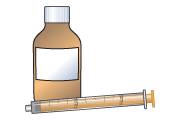Chloral hydrate for dsytonia
This leaflet is for parents and carers about how to use this medicine in children. Our information may differ from that provided by the manufacturers, because their information usually relates to adults. Read this leaflet carefully. Keep it somewhere safe so that you can read it again.
Chloral hydrate should only be used to help your child’s dystonia if your specialist has prescribed it for this use.
Do not stop giving Chloral hydrate suddenly, as your child is likely to get withdrawal symptoms
Name of medicine
Chloral hydrate
Why is it important for my child to take Chloral hydrate?
Children with dystonia get painful and distressing movements and muscle spasms, which may make sitting difficult and also prevent sleep. Chloral hydrate is a sedative. It will help calm your child.
Chloral hydrate can only be prescribed by a specialist as part of a symptoms management plan that states how long it can be used for.
What is Chloral hydrate available as?
Liquid medicine: 143 mg, 200 mg or 500 mg per 5 mL
When should I give Chloral hydrate
Your child’s symptom management plan will state how often you can give this medicine to your child. The maximum is 6 times in 24 hours. These times must be at least 4 hours apart.
How much should I give?
Your doctor will work out the amount of Chloral hydrate (the dose) that is right for your child. The dose will be shown on the medicine label.
It is important that you follow your doctor’s instructions about how much to give.
Chloral hydrate is a sedative and can be dangerous if too much is given.
How should I give Chloral hydrate?

Liquid medicine
- Shake the medicine well. Measure out the right amount using an oral syringe or a medicine spoon. You can get these from your pharmacist. Do not use a kitchen teaspoon as it will not give the right amount.
- To hide the taste of the liquid medicine, you can add the dose into a small glass of juice or squash (preferably at room temperature).
- Your child should drink all the mixture straight away.
When should the medicine start working?
The medicine will start to work within 30 minutes.
If your child has been taking chloral hydrate for some time, it may seem to work less well. If this happens, contact your specialist for advice.
Do not increase the dose of Chloral hydrate unless your specialist has told you to.
What if my child is sick (vomits)?
Do not give a second dose of Chloral hydrate. Contact your doctor, nurse or pharmacist for advice.
What if I forget to give it?
Give the missed dose straight away. Wait at least 4 hours before giving another dose.
Never give a double dose of Chloral hydrate, unless your doctor has told you to.
What if I give too much?
If your child has any, or all, of the following symptoms they may have had too much chloral hydrate:
- Difficulty breathing
- You are unable to wake your child
- They seem particularly weak
- Their pupils (the black circles in the eyes) are tiny
- Your child feels that their heart is racing.
If you think your child may have had too much Chloral hydrate, contact your doctor or take your child to hospital straight away. Tell the doctor that they may have had too much Chloral hydrate. Take the medicine or packaging with you, so that the doctor can see what has been taken. Have the packaging with you if you telephone for advice.
Are there any possible side effects?
We use medicines to make our children better, but sometimes they have other effects that we don’t want (side-effects).
Side effects you must do something about
If your child has difficulty breathing, develops a rash, or seems particularly weak or tired, take them to hospital or call for an ambulance.
Other side-effects you need to know about
Your child may feel dizzy and confused or may be less alert than usual.
They may have nausea (feel sick), vomit (be sick) or diarrhoea. Contact your doctor if these symptoms become a problem.
Your child may have wind and bloating (swollen belly).
They may seem excitable.
Your child may get headaches.
They may lose coordination.
Your child may sometimes get side-effects that are not listed above. If you notice anything unusual and are concerned, contact your doctor. You can report any suspected side-effects to the UK safety scheme at mhra.gov.uk/yellowcard.
More information on side-effects can be found in a leaflet on our website.
Can other medicines be given at the same time as Chloral hydrate?
Your child should not have any medicine that makes them drowsy as chloral hydrate has this effect. This includes medicines that are bought over the counter from a pharmacy or at a shop and herbal and complementary medicines.
- Chloral hydrate should not be taken with some medicines that you get on prescription. Tell your doctor and pharmacist about any other medicines your child is taking before giving Chloral hydrate. This includes herbal or complementary medicines.
Check with your doctor or pharmacist before giving any other medicines to your child. This includes herbal and complementary medicines.
Is there anything else I need to know about this medicine?
Do not stop giving Chloral hydrate suddenly, as your child may get withdrawal effects and feel unwell. If you or your child wants to stop taking Chloral hydrate, discuss this with your doctor. They will explain how to reduce the dose bit by bit.
When you get a new bottle of liquid medicine, check what strength you have been given and how much to give your child, as this may be different from the previous supply. If you are not sure how much to give, contact your doctor, pharmacist or nurse.
Each time you open a new bottle of liquid medicine, check how long you can use it for, as the expiry dates may differ with different liquid medicines.
Chloral hydrate may make your child drowsy (sleepy). They need to take extra care when taking part in physical activities. You should tell your child’s teacher that they are taking Chloral hydrate and that they may feel drowsy.
General advice about medicines
- Try to give medicines at about the same times each day, to help you remember.
- If you are not sure a medicine is working, contact your doctor but continue to give the medicine as usual in the meantime. Do not give extra doses, as you may do harm.
- If you think someone else may have taken the medicine, contact a doctor straight away.
- Write down the times that you give Chloral hydrate, to help you remember, and to make sure that you don’t give too much.
- Make sure that you always have enough medicine. Order a new prescription at least 2 weeks before you will run out.
- Make sure that the medicines you have at home have not reached the ‘use by’ date on the packaging. Give old medicines to your pharmacist to dispose of.
- Only give this medicine to your child. Never give it to anyone else, even if their condition appears to be the same, as this could do harm.
Where should I keep this medicine?
- Keep the medicine in a cupboard, away from heat and direct sunlight. It does not need to be kept in the fridge.
- Make sure that children cannot see or reach the medicine.
- Keep the medicine in the container it came in.
Who to contact for more information?
Your doctor, pharmacist or nurse will be able to give you more information about Chloral hydrate and about other medicines used to treat dystonia.
England: NHS 111
Tel 111
www.nhs.ukScotland: NHS 24
Tel 111
www.nhs24.scotNorthern Ireland: NI Direct
Wales: NHS 111 Wales
Tel 111
www.111.wales.nhs.ukDystonia UK
020 7793 3651
www.dystonia.org.uk/Copyright disclaimer
Version [1]. © NPPG, RCPCH and WellChild, all rights reserved. Review by May 2027.
The primary source for the information in this leaflet is the British National Formulary for Children. For details on any other sources used for this leaflet, please contact us through our website, www.medicinesforchildren.org.uk.
We take great care to make sure that the information in this leaflet is correct and up-to-date. However, medicines can be used in different ways for different patients. It is important that you ask the advice of your doctor or pharmacist if you are not sure about something. This leaflet is about the use of these medicines in the UK, and may not apply to other countries. The Royal College of Paediatrics and Child Health (RCPCH), the Neonatal and Paediatric Pharmacists Group (NPPG), WellChild and the contributors and editors cannot be held responsible for the accuracy of information, omissions of information, or any actions that may be taken as a consequence of reading this leaflet.
